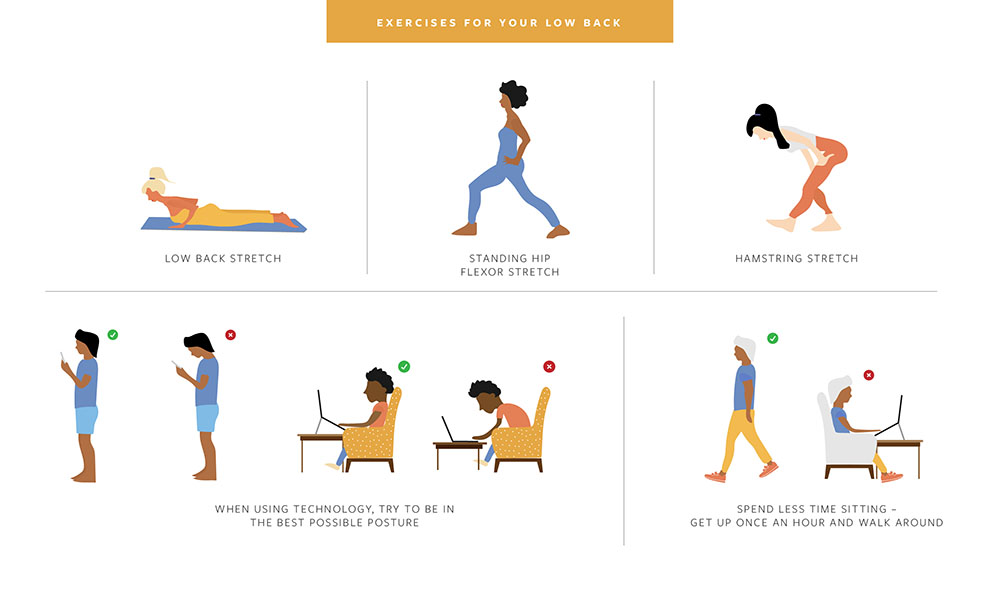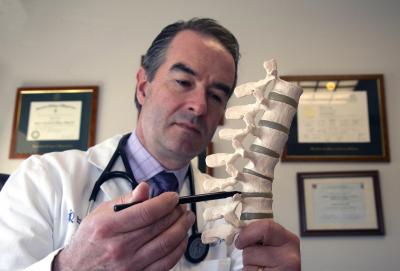Visit Blue Cross' new health news site, Coverage, for compelling original reporting on health and wellness issues. Sign up to get our weekly headlines in your inbox!
Last summer, Sawrah Amini experienced such severe pain in her low back that she could barely get out of bed.
Amini, a yoga instructor in Central Massachusetts, had a hunch that her pain was muscular. She thought it was due to a few factors: a change in her sleeping position, hoisting herself in and out of a pickup truck, and sitting for long hours at her yoga studio computer.
But instead of calling her doctor to make an appointment, she said, “I called my massage therapist for an emergency massage.” She took other steps to treat her back at home, including taking ibuprofen, applying Tiger Balm, ice and a heating pad, and stretching through a series of yoga postures. This not only aided her aching back but also brightened her mood and helped her better manage her pain.
After a few days, she said, she was “moving around gingerly,” and within a month she felt much better.
A common complaint
Amini is not alone.
“Nationally, low back pain is the second most common reason for a sick visit in adult primary care, behind viral respiratory illnesses, at 13 million office visits a year,” said Dr. Jayson Carr, a primary care provider with Beth Israel Deaconess Health Care in Brookline. He sees so many patients with low back pain complaints that he keeps a plastic model of the spine in his office to help explain spinal issues. “In modern life, you’re going to have low back pain at some point,” Carr said.
That can be attributed to a perfect storm of factors—an aging population with aging spines, and an uptick in both the populations of ambitious athletic weekend warriors as well as those with sedentary lifestyles and struggles with obesity.
About 35,000 Blue Cross Blue Shield of Massachusetts commercial members saw a doctor for low back pain in 2018, and cases are on the rise.
“Low back pain is very common and can be experienced by people of any age, sex, size for a variety of reasons,” said Blue Cross Vice President of Clinical Programs and Strategy Dr. Katherine Dallow, noting the condition doesn’t discriminate. “People who do manual labor can experience low back pain as much as people with desk jobs for totally different reasons.”
The good news, Carr says, is that most low back pain is due to a muscular strain. It usually resolves in a few weeks with the recommended treatment of moderate physical activity, pain relievers like ibuprofen or acetaminophen and medicated back patches.
Physical therapy and stretching—including the kind of yoga stretches Amini did—may also be helpful for pain that lasts more than a few weeks.
“Besides these treatments, there’s not much else for people to do other than be patient,” Carr said.
Prescribing patience, not an X-ray or MRI
Doctors say two of the most common misconceptions about low back pain are that it will resolve within days, and that it requires an X-ray or an MRI.
“Patients usually want an image because they want an answer,” Carr said, “but a careful review of your history and a physical exam can give you the answer.”
Unnecessary imaging, Carr said, means needless exposure to radiation. It also can lead to an increased chance of unnecessary surgery with steep costs, delays in returning to work and regular activity, and subsequent deconditioning.
Dallow agrees. “Images done on an individual who has had back pain for less than 30 days and has no red flags can actually misdirect treatment.”
Instead of asking for an X-ray or MRI, patients should tell their doctor how their back pain started, describe their symptoms, and ask how they can expect their recovery to progress, Carr said.
Realistic expectations are important, he added. “People come in and expect to feel better in 2-3 days, versus the reality of 2-3 weeks,” Carr said.
“No one over the age of 40 has a normal-looking lumbar spine MRI,” he said. “We all have some ‘gray hair’ signs of the spine. As we age, discs lose elasticity and hydration.”
How to avoid low back pain in the first place
There’s no sure-fire method, since it’s often a fact of life, Carr says. However, he encourages his patients to stay active; lift with their legs instead of their back; and avoid shoveling snow if they can—something that can be hard to do in New England.
Yoga instructor Amini says she is working on preventing future back pain by continuing to do a special series of yoga poses three times a week. Because she is small in stature, she also has placed a yoga block under her feet when she’s at her desk to improve her posture when seated.
She is not alone, she knows.
“At the start of class,” she said, “I often take requests from participants about which areas of the body they want to focus on during the session.” One of her students’ most common requests? You guessed it: "the back.”


